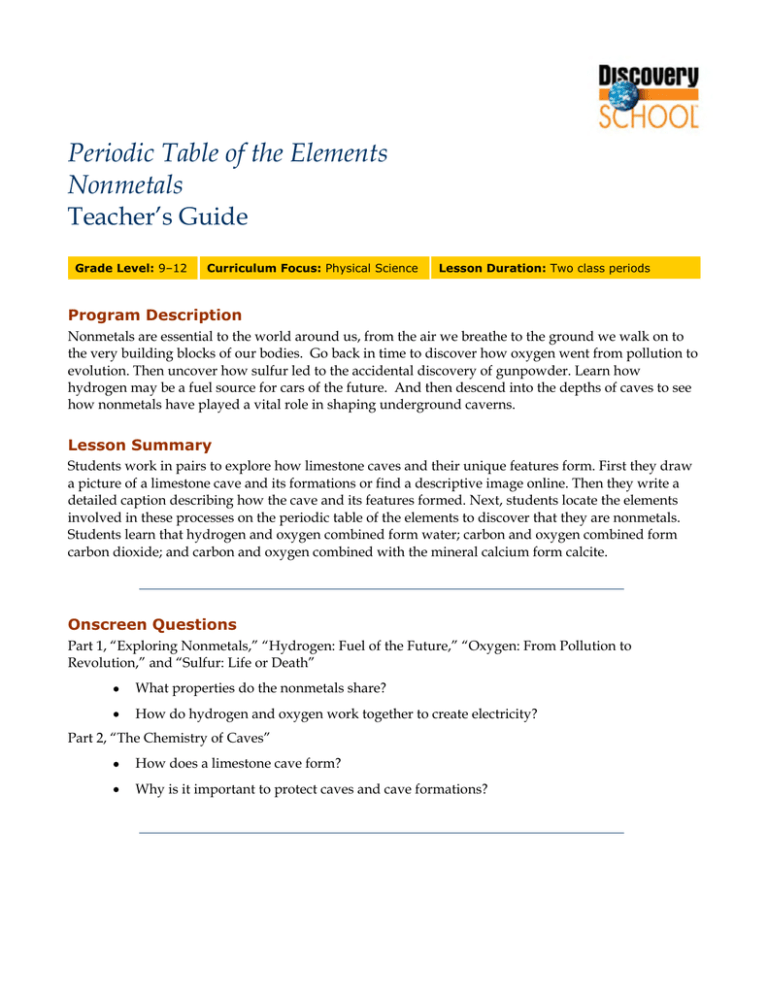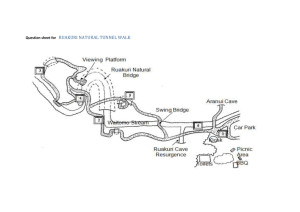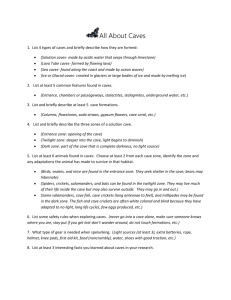
Periodic Table of the Elements
Nonmetals
Teacher’s Guide
Grade Level: 9–12
Curriculum Focus: Physical Science
Lesson Duration: Two class periods
Program Description
Nonmetals are essential to the world around us, from the air we breathe to the ground we walk on to
the very building blocks of our bodies. Go back in time to discover how oxygen went from pollution to
evolution. Then uncover how sulfur led to the accidental discovery of gunpowder. Learn how
hydrogen may be a fuel source for cars of the future. And then descend into the depths of caves to see
how nonmetals have played a vital role in shaping underground caverns.
Lesson Summary
Students work in pairs to explore how limestone caves and their unique features form. First they draw
a picture of a limestone cave and its formations or find a descriptive image online. Then they write a
detailed caption describing how the cave and its features formed. Next, students locate the elements
involved in these processes on the periodic table of the elements to discover that they are nonmetals.
Students learn that hydrogen and oxygen combined form water; carbon and oxygen combined form
carbon dioxide; and carbon and oxygen combined with the mineral calcium form calcite.
Onscreen Questions
Part 1, “Exploring Nonmetals,” “Hydrogen: Fuel of the Future,” “Oxygen: From Pollution to
Revolution,” and “Sulfur: Life or Death”
•
What properties do the nonmetals share?
•
How do hydrogen and oxygen work together to create electricity?
Part 2, “The Chemistry of Caves”
•
How does a limestone cave form?
•
Why is it important to protect caves and cave formations?
Periodic Table of the Elements
Nonmetals
Teacher’s Guide
Lesson Plan
Student Objectives
•
Describe the chemical processes involved in cave formation.
•
Explain the chemistry behind the development of at least two features found in caves.
•
Identify the elements involved in cave formation on the periodic table of the elements.
•
Describe how these elements combine to form the compounds that contribute to the
formation of caves.
Materials
•
Nonmetals program
•
Computer with Internet access
•
Poster board
•
Markers and colored pencils
•
Index cards
•
Tape
•
Copy of the periodic table of the elements
Procedures
1. Begin the lesson by asking students if they have ever visited a cave. If so, ask them to write
down any distinctive features they remember from their visit. Then tell students to put the
paper away until the end of the lesson.
2. Have students watch the segment “The Chemistry of Caves” in the program Nonmetals. Ask
students to focus on limestone caves and how they form, as well as on how unique features
found inside the caves form.
3. Divide the class into pairs. Tell each pair to either draw a picture of a limestone cave or find
a picture online. Then ask students to develop a detailed caption describing the chemical
processes involved in the formation of the cave. Their cave image should include at least two
unique features, such as stalactites and stalagmites, and students should write a description
of how these features form as well. Students can write their descriptions on index cards and
tape them below their image.
4. Give students time in class to work on their projects. The Web sites below provide
information.
Cave Formation
http://www.nps.gov/wica/Speleothems.htm
http://www.geocities.com/jdfahn/caves.html
Published by Discovery Education. © 2005. All rights reserved.
2
Periodic Table of the Elements
Nonmetals
Teacher’s Guide
3
http://www.reference.com/browse/wiki/Speleothem
http://www.goodearthgraphics.com/virtcave/stalmite/stalmite.html
5. For your information, below is a brief description of how limestone caves and two features
inside caves form.
•
Limestone caves form when water seeps into cracks in the rock. Because the water has been
exposed to carbon dioxide from the air and soil, the water forms a mild acid, called carbonic
acid. Over a long period of time, the carbonic acid causes the rock to dissolve, resulting in
the formation of a cave.
•
As the water travels through the cave, it loses the carbon dioxide that has been dissolved in
it. As a result, the water cannot hold as much of the dissolved calcium. The excess calcium
then falls out of the solution and ends up on the cave walls and ceilings as the mineral
calcite. The result is interesting formations inside the caves. These formations are called
speleothems.
•
Stalactites are speleothems that hang from the ceiling of the cave. Stalagmites grow up from
the floor of the cave. Other formations, called popcorn, develop on cave walls. As water
drips out of the walls, the calcite falls out of the solution and clusters on the cave walls,
creating shapes that resemble popcorn.
6. During the next class period, give students a little more time to finish their captions and
drawings. Then ask for volunteers to share their ideas about how caves and their unique
features form.
7. Refer students to the periodic table of the elements. Ask for volunteers to identify the
elements involved in cave formation. Students should now know that hydrogen, oxygen, and
carbon—all nonmetals—combine to form the compounds that lead to the formation of caves.
Ask students to name the compounds and the elements that caves are made from. If students
need prompting, remind them that water and carbon dioxide are involved in cave formation.
(Hydrogen and oxygen combine to form water. Carbon and oxygen combine to form carbon dioxide.
Carbon dioxide and water create the acid that causes caves to form.)
8. Conclude the lesson by asking students to look at the ideas about caves that they recorded
before they began work on this project. If students had visited a cave, do they now
understand how its features formed? If not, can they now explain to family and friends how
nonmetals combine to form limestone caves?
Assessment
Use the following three-point rubric to evaluate students’ work during this lesson.
•
3 points: Students demonstrated a clear understanding of the chemistry behind the
formation of caves and their unique features; identified all the nonmetals on the periodic
table that combine to form the compounds involved in the formation of caves; were able to
identified all the compounds involved in cave formation.
Published by Discovery Education. © 2005. All rights reserved.
Periodic Table of the Elements
Nonmetals
Teacher’s Guide
4
•
2 points: Students demonstrated a satisfactory understanding of the chemistry behind the
formation of caves and their unique features; identified most of the nonmetals on the
periodic table that combine to form the compounds involved in the formation of caves;
identified most of the compounds involved in cave formation.
•
1 point: Students demonstrated a poor understanding of the chemistry behind the formation
of caves and their unique features; were not able to identify the nonmetals on the periodic
table that combine to form the compounds involved in the formation of caves; were not able
to identify the compounds involved in cave formation.
Vocabulary
limestone cave
Definition: An underground opening formed when water, mixed with carbon dioxide from the
air and soil, seeps into limestone rock, causing the rock to dissolve; this process takes place over
very long periods of time
Context: Mammoth Cave in Kentucky is an example of a limestone cave that has a large
underground chamber and many tunnels and passageways.
nonmetals
Definition: A group of elements, many of which are gases at room temperature, that make up
many of the materials found on Earth
Context: Oxygen is an example of a nonmetal that is highly reactive and can combine with
almost every other element on Earth.
periodic table of the elements
Definition: An organization of Earth’s elements arranged according to atomic number, the
number of protons each element’s nucleus contains
Context: Dmitri Mendeleev, a Russian scientist, developed the first periodic table of the elements
in 1869, and it was organized according to the atomic mass of each element.
speleothem
Definition: A distinctive feature that forms in a cave
Context: Speleothems encompass a wide variety of cave formations, including popcorn and
flowstone.
stalactite
Definition: A type of cave formation that forms from the ceiling of a cave and hangs down
Context: Stalactites look like icicles, but instead of forming from water, they form from the
mineral calcite.
Published by Discovery Education. © 2005. All rights reserved.
Periodic Table of the Elements
Nonmetals
Teacher’s Guide
5
Academic Standards
Mid-continent Research for Education and Learning (McREL)
McREL’s Content Knowledge: A Compendium of Standards and Benchmarks for K–12 Education
addresses 14 content areas. To view the standards and benchmarks, visit http://www.mcrel.org/.
This lesson plan addresses the following national standards:
•
Physical Sciences: Understands the structure and property of matter
•
Language Arts—Viewing: Uses viewing skills and strategies to understand and interpret
visual media
National Academy of Sciences
The National Academy of Sciences provides guidelines for teaching science in grades K–12 to
promote scientific literacy. To view the standards, visit this Web site:
http://books.nap.edu/html/nses/html/overview.html#content.
This lesson plan addresses the following national standards:
•
Physical Science: Chemical reactions
•
Physical Science: Structure and properties of matter
Support Materials
Develop custom worksheets, educational puzzles, online quizzes, and more with the free teaching tools
offered on the Discoveryschool.com Web site. Create and print support materials, or save them to a
Custom Classroom account for future use. To learn more, visit
•
http://school.discovery.com/teachingtools/teachingtools.html
DVD Content
This program is available in an interactive DVD format. The following information and activities are
specific to the DVD version.
How To Use the DVD
The DVD starting screen has the following options:
Published by Discovery Education. © 2005. All rights reserved.
Periodic Table of the Elements
Nonmetals
Teacher’s Guide
6
Play Video—This plays the video from start to finish. There are no programmed stops, except by
using a remote control. With a computer, depending on the particular software player, a pause button
is included with the other video controls.
Video Index—Here the video is divided into sections indicated by video thumbnail icons; brief
descriptions are noted for each one. Watching all parts in sequence is similar to watching the video
from start to finish. To play a particular segment, press Enter on the remote for TV playback; on a
computer, click once to highlight a thumbnail and read the accompanying text description and click
again to start the video.
Curriculum Units—These are specially edited video segments pulled from different sections of the
video (see below). These nonlinear segments align with key ideas in the unit of instruction. They
include onscreen pre- and post-viewing questions, reproduced below in this Teacher’s Guide. Total
running times for these segments are noted. To play a particular segment, press Enter on the TV
remote or click once on the Curriculum Unit title on a computer.
Standards Link—Selecting this option displays a single screen that lists the national academic
standards the video addresses.
Teacher Resources—This screen gives the technical support number and Web site address.
Video Index
I. Exploring Nonmetals (6 min.)
Far fewer than metals on the periodic table, the nonmetals are essential components of many of
Earth’s natural resources. Explore their properties and uses.
II. Hydrogen: Fuel of the Future (7 min.)
Hydrogen is the simplest element in the universe—and the most abundant. Discover why it may
become a fuel alternative in the 21st century.
III. Oxygen: From Pollution to Revolution (5 min.)
When first released into the atmosphere about 2.5 billion years ago, oxygen was lethal. Now it’s an
essential component of the air we breathe.
IV. Sulfur: Life or Death (5 min.)
A key ingredient in gunpowder, sulfur is a nonmetal element found in several different forms,
or allotropes.
V. The Chemistry of Caves (23 min.)
Investigate the unusual ecosystems inside caves and discover the role limestone plays in their
formation.
Published by Discovery Education. © 2005. All rights reserved.
Periodic Table of the Elements
Nonmetals
Teacher’s Guide
7
Curriculum Units
1. Properties of Nonmetals
Pre-viewing question
Q: What elements are commonly found in nature?
A: Answers will vary.
Post-viewing question
Q: What does the position of the nonmetals on the periodic table indicate?
A: The nonmetals are on the far right of the periodic table. Not including hydrogen, they span groups
14 to 16 and have between four and six valence electrons. Hydrogen is in group 1 above the alkaline
metals, but it behaves like the nonmetals in most circumstances.
2. Properties and Uses of Hydrogen
Pre-viewing question
Q: What do you know about hydrogen?
A: Answers will vary.
Post-viewing question
Q: What are some common uses of hydrogen?
A: Combining easily with other elements, common hydrogen compounds include water, table sugar,
ammonia, and hydrogen peroxide. Liquid hydrogen is often combined with liquid oxygen to make
rocket fuel.
3. Alternative Fuel Source
Pre-viewing question
Q: What are some drawbacks of using gasoline to fuel automobiles?
A: Answers may include that gasoline is a nonrenewable resource; it causes air pollution and acid rain;
it is expensive; and pollution from gasoline emissions may contribute to global warming.
Post-viewing question
Q: Why is hydrogen being considered to fuel the cars of the future?
A: The Earth’s supply of hydrogen is limitless because it is the most abundant element in the universe,
and it is odorless, tasteless, and nontoxic. The only waste product of hydrogen fuel cells would be
water. Hydrogen fuel cells have no mechanical parts, do not operate at high temperatures, and do not
need lubricating oils. Maintaining hydrogen-fueled cars should be cheaper and easier than traditional
vehicles.
4. Properties and Uses of Oxygen
Pre-viewing question
Q: What are some uses of oxygen?
A: Answers will vary.
Published by Discovery Education. © 2005. All rights reserved.
Periodic Table of the Elements
Nonmetals
Teacher’s Guide
8
Post-viewing question
Q: Describe the properties of oxygen.
A: A highly reactive element, oxygen is a colorless, odorless, tasteless, nonflammable gas. In its most
common form, an atom of oxygen has eight positively charged protons and eight neutral neutrons in its
nucleus; its eight negatively charged electrons circle the nucleus in orbital shells to balance its eight
protons.
5. Prehistoric Air Pollution
Pre-viewing question
Q: How does air pollution affect people?
A: Answers will vary.
Post-viewing question
Q: How did oxygen released into the atmosphere about 2.5 billion years ago change life on Earth?
A: The oxygen introduced into the atmosphere about 2.5 billion years ago was lethal to many bacteria,
and many organisms died out. Those that could adapt to the oxygen-rich atmosphere found that the
element could be used to produce energy more efficiently. Once deadly, oxygen eventually became
necessary for nearly living organisms on Earth.
6. Properties and Uses of Sulfur
Pre-viewing question
Q: What do you know about sulfur and its uses?
A: Answers will vary.
Post-viewing question
Q: What are some forms of sulfur?
A: Sulfur exists in allotropes, or a number of different forms. The most common at room temperature is
yellow sulfur; it begins to melt at 115° Celsius, turning into an orange liquid. As the temperature rises
above 175° Celsius, sulfur becomes black and viscous, similar to molasses. Poured into water, the
viscous form turns into a flexible mass known as plastic sulfur.
7. Alchemy and Gunpowder
Pre-viewing question
Q: What were the goals of medieval alchemy?
A: Alchemy was a chemical philosophy with three goals: to turn base metal into gold, to find the
universal cure for all diseases, and to prolong life indefinitely.
Post-viewing question
Q: How does gunpowder work?
A: The explosion of gunpowder is a simple reaction. Charcoal works as fuel, and sulfur is a stabilizer.
Its main ingredient is potassium nitrate, which provides extra oxygen and allows the mixture to
explode instead of burn slowly.
Published by Discovery Education. © 2005. All rights reserved.
Periodic Table of the Elements
Nonmetals
Teacher’s Guide
9
8. Exploring Caves
Pre-viewing question
Q: What might be interesting about exploring a cave?
A: Answers will vary.
Post-viewing question
Q: Why do scientists explore caves?
A: Archeologists study prehistoric art and artifacts. Geologists consider them as windows into the
history of our planet. Biologists study their unique ecological communities; a single cave may house
creatures that exist nowhere else on the planet.
9. Exploring Mammoth Cave
Pre-viewing question
Q: Have you ever explored a cave?
A: Answers will vary.
Post-viewing question
Q: Describe the layout of Mammoth Cave.
A: The longest known cave in the world, Mammoth Cave is a three-dimensional system with multilevel
galleries and 356 miles of passages, some of which may run 600 feet deep. Scientists estimate that up to
500 additional miles might exist in this cave system.
10. The Formation of Mammoth Cave
Pre-viewing question
Q: Why might early humans have explored caves?
A: Answers will vary.
Post-viewing question
Q: How long did it take Mammoth Cave to form?
A: Mammoth Cave took some three to five million years to form.
11. Cave Formations
Pre-viewing question
Q: How does water help shape the landscape of our planet?
A: Answers will vary.
Post-viewing question
Q: What is the difference between a stalactite and a stalagmites?
A: A stalactite is a mineral formation hanging from the ceiling of a cave like an icicle. A stalagmite
grows upward. Both grow very slowly, in some cases only one-stenth of a millimeter a year.
Published by Discovery Education. © 2005. All rights reserved.
Periodic Table of the Elements
Nonmetals
Teacher’s Guide
10
12. Specialized Ecosystem
Pre-viewing question
Q: What kinds of ecosystems exist on Earth?
A: Answers will vary.
Post-viewing question
Q: Why do caves exhibit specialized ecosystems?
A: A cave’s ecosystem had adapted to the conditions in its environment, which includes no sunlight,
nearly 100 percent humidity at all times, and very limited food sources. A cave’s temperature range is
usually about one degree, regardless of the outside temperature.
13. Florida’s Underwater Caves
Pre-viewing question
Q: What would you expect to find in an underwater cave?
A: Answers will vary.
Post-viewing question
Q: What are chemosynthetic bacteria?
A: Found in underwater caves, chemosynthetic bacteria are a newly discovered form of bacteria that
synthesize energy from metals and minerals instead of from organic food. They may resemble the
earliest forms of life on Earth.
Published by Discovery Education. © 2005. All rights reserved.








